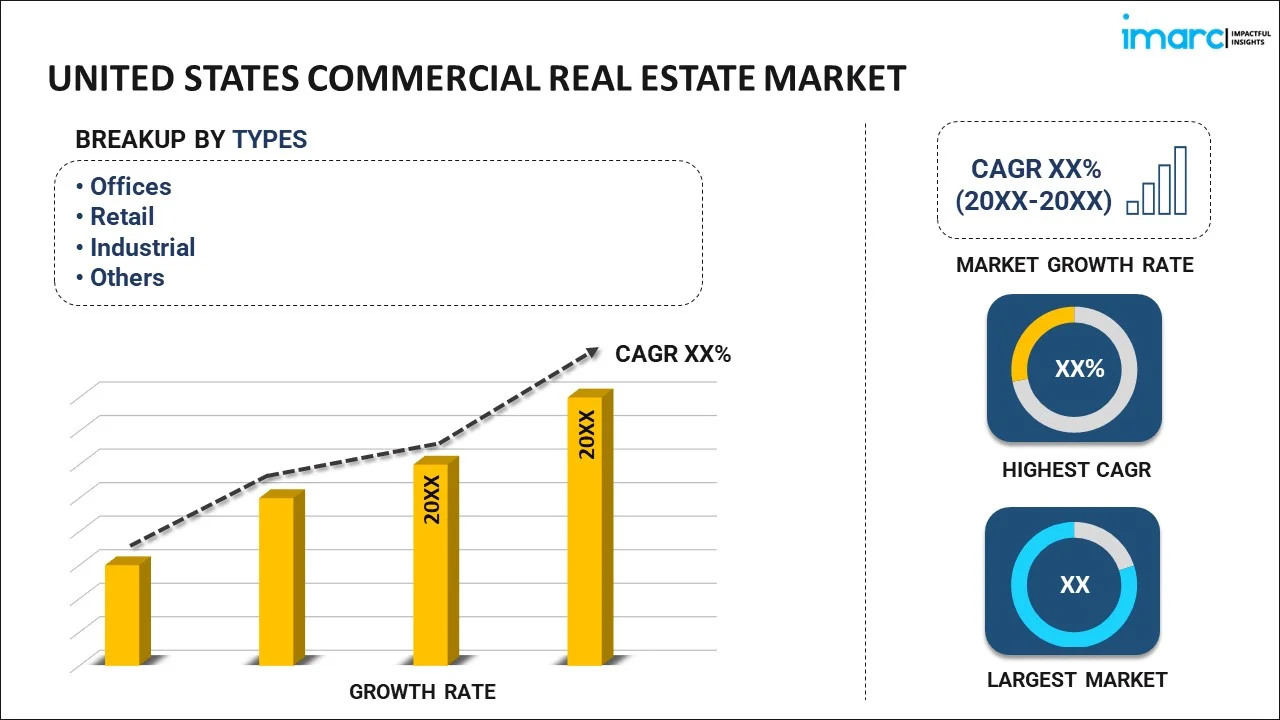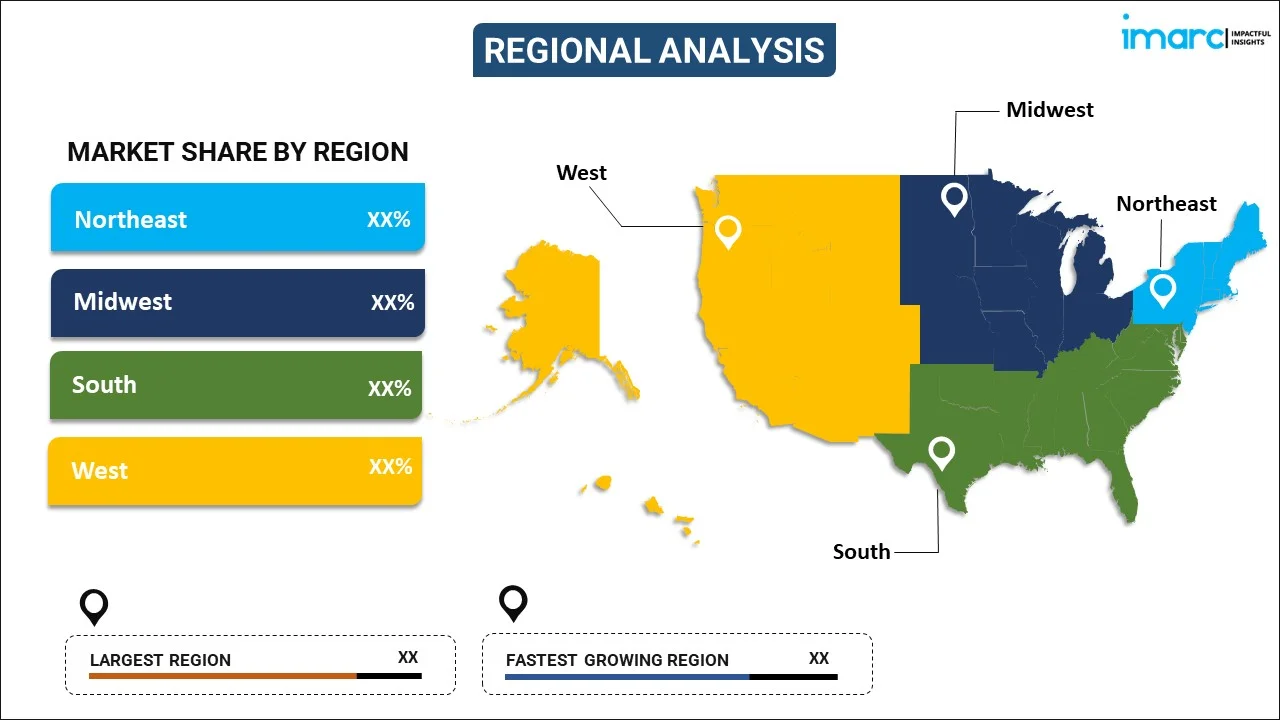
United States Commercial Real Estate Market Report by Type (Offices, Retail, Industrial, Logistics, Multi-Family, Hospitality), and Region 2026-2034
Market Overview:
United States commercial real estate market size reached USD 742.3 Billion in 2025. Looking forward, IMARC Group expects the market to reach USD 995.6 Billion by 2034, exhibiting a growth rate (CAGR) of 3.32% during 2026-2034. The increasing number of shopping centers, manufacturing plants, corporate headquarters, and logistics hubs, which is contributing significantly to the functionality and vibrancy of various industries, is primarily driving the market growth.
|
Report Attribute
|
Key Statistics
|
|---|---|
|
Base Year
|
2025
|
|
Forecast Years
|
2026-2034
|
|
Historical Years
|
2020-2025
|
|
Market Size in 2025
|
USD 742.3 Billion |
|
Market Forecast in 2034
|
USD 995.6 Billion |
| Market Growth Rate 2026-2034 | 3.32% |
Access the full market insights report Request Sample
United States Commercial Real Estate Market Analysis:
- Key Market Drivers: Growth in logistics, urban infrastructure, and tech-enabled offices is driving investor interest. Rising workforce mobility and strategic migration to secondary cities are further fueling long-term development and investment momentum in commercial spaces across the United States.
- Key Market Trends: Sustainable construction, intelligent buildings, and adaptable leasing terms characterize United States commercial real estate market trends. Developers are responding to changing tenant needs by combining efficiency with technology to maximize operation and secure long-term commercial tenancy.
- Competitive Landscape: Institutional and private players are diversifying portfolio across sectors such as medical offices and warehousing. Market participants target core urban areas and innovation-driven submarkets for predictable returns, while considering asset repositioning to address evolving commercial demand.
- Challenges and Opportunities: With interest rate uncertainty, opportunity zones, adaptive reuse, and urban redevelopment providing high growth potential. United States commercial real estate market demand continues strong, particularly for mixed-use, sustainable developments serving changing workplace and retail dynamics.
Commercial real estate encompasses properties designated for business use, including offices, retail establishments, hotels, industrial facilities, and warehouses. In contrast to residential real estate, which primarily serves as living spaces, commercial properties are designed to generate income through rentals, leases, or sales. These properties serve as the infrastructure for a diverse array of business operations, including corporate offices, shopping complexes, manufacturing facilities, and logistics centers. The commercial real estate sector plays a crucial role in influencing the layout of urban areas and providing essential support to industries spanning various sectors.
United States Commercial Real Estate Market Trends:
Expansion of Mixed-Use Developments
Mixed-use developments in the United States are rapidly changing commercial real estate, especially in urban and suburban centers. The development combines residential, office, and retail elements to create walkable communities that enhance convenience, sustainability, and lifestyle synergy. Municipalities are increasingly open to rezoning initiatives supporting such vertical or horizontal combination as part of smart urban planning initiatives. Developers and investors are drawn to the long-term value proposition of mixed-use properties because of their diverse tenant population and high footfall potential. Consequently, this sector is gaining a growing share of United States commercial real estate market share. The need for spaces that provide both functional and experiential utility is increasing, causing planners to create assets catering to multiple demographic requirements. With changing consumer behavior, these trends are a strategic reflection of shifting work, living, and commercial patterns, hence increasing occupancy levels and helping maintain value in competitive markets.
Industrial and Logistics Real Estate Growth
The exponential growth in the industrial and logistics space is being driven by the rise in e-commerce and the strategic focus on agile, localized supply chains. Throughout the United States, capital is being largely invested in contemporary warehouses, cold storage, and distribution facilities that can satisfy the operational needs of omnichannel retailing and manufacturing. Those facilities that have cutting-edge automation systems, sustainability components, and locations near transportation intermodal hubs are gaining more interest. As per the sources, In February 2025, Fast Company Executive Board reported that 64% of U.S. commercial real estate borrowers, lenders, and investors had active sustainability programs, highlighting ESG integration as a core driver of market profitability. Moreover, occupancy levels are high, with most markets seeing minimal vacancy and upward pressure on rents. This is one of the major drivers of overall United States commercial real estate market growth since it illustrates the way sectoral change in retail and distribution is reconfiguring spatial requirements. Developers are reacting with dedicated logistics parks and last-mile fulfillment centers, especially in metropolitan peripheries. These areas are not just practical but strategically located to maximize delivery efficiencies, thus making industrial real estate the most dynamic and resilient sector in the property market.
Increased Demand for Flexible Office Formats
With hybrid work models taking hold in sectors, flexible office formats are transforming the United States commercial property market. With business entities placing greater value on lease flexibility, technology incorporation, and people-friendly spaces over conventional long-term lease holding agreements, the demand for flexible office formats is on the rise. This shift has resulted in increased adoption of coworking facilities, on-demand office suites, and activity-based workspaces. Developers and landlords in central business districts are repurposing existing office assets to support modular design and collaboration areas that complement changing workforce demands. These shifts are facilitated by an increase in amenities like wellness centers, touchless entry, and smart HVAC systems, leading to improved tenant satisfaction and retention. As workplace strategies keep progressing, these tastes are an essential component of United States commercial real estate market analysis, reflecting a more extensive shift in office real estate fundamentals. Flexible formats are no longer niche products but are increasingly becoming integrated into the way that space is leased, occupied, and valued nationwide.
United States Commercial Real Estate Market Segmentation:
IMARC Group provides an analysis of the key trends in each segment of the market, along with forecasts at the country level for 2026-2034. Our report has categorized the market based on type.
Type Insights:

To get detailed segment analysis of this market Request Sample
- Offices
- Retail
- Industrial
- Logistics
- Multi-Family
- Hospitality
The report has provided a detailed breakup and analysis of the market based on the type. This includes offices, retail, industrial, logistics, multi-family, and hospitality.
Regional Insights:

To get detailed regional analysis of this market Request Sample
- Northeast
- Midwest
- South
- West
The report has also provided a comprehensive analysis of all the major regional markets, which include Northeast, Midwest, South, and West.
Competitive Landscape:
The market research report has also provided a comprehensive analysis of the competitive landscape in the market. Competitive analysis such as market structure, key player positioning, top winning strategies, competitive dashboard, and company evaluation quadrant has been covered in the report. Also, detailed profiles of all major companies have been provided.
Latest News and Developments:
- In July 2025, WeWork started its "WeWork for Business" campaign with the objective of positioning itself as a mature commercial real estate company. CMO Petula Lucey spearheaded the campaign, which is away from its startup origins to a professional office space company driven by stability, scale, and enterprise-level services.
United States Commercial Real Estate Market Report Coverage:
| Report Features | Details |
|---|---|
| Base Year of the Analysis | 2025 |
| Historical Period | 2020-2025 |
| Forecast Period | 2026-2034 |
| Units | Billion USD |
| Scope of the Report | Exploration of Historical and Forecast Trends, Industry Catalysts and Challenges, Segment-Wise Historical and Predictive Market Assessment:
|
| Types Covered | Offices, Retail, Industrial, Logistics, Multi-Family, Hospitality |
| Regions Covered | Northeast, Midwest, South, West |
| Customization Scope | 10% Free Customization |
| Post-Sale Analyst Support | 10-12 Weeks |
| Delivery Format | PDF and Excel through Email (We can also provide the editable version of the report in PPT/Word format on special request) |
Key Benefits for Stakeholders:
- IMARC’s industry report offers a comprehensive quantitative analysis of various market segments, historical and current market trends, market forecasts, and dynamics of the United States commercial real estate market from 2020-2034.
- The research report provides the latest information on the market drivers, challenges, and opportunities in the United States commercial real estate market.
- Porter's five forces analysis assist stakeholders in assessing the impact of new entrants, competitive rivalry, supplier power, buyer power, and the threat of substitution. It helps stakeholders to analyze the level of competition within the United States commercial real estate industry and its attractiveness.
- Competitive landscape allows stakeholders to understand their competitive environment and provides an insight into the current positions of key players in the market.
Key Questions Answered in This Report
The commercial real estate market in the United States was valued at USD 742.3 Billion in 2025.
The United States commercial real estate market is projected to exhibit a (CAGR) of 3.32% during 2026-2034, reaching a value of USD 995.6 Billion by 2034.
The key drivers of the United States commercial real estate market are increasing demand for flexible office space, expansion of e-commerce leading to growth in logistics and warehousing, urbanization, investment in infrastructure, and low interest rates. Furthermore, technology uptake and the preference of tenants for efficient, intelligent buildings are transforming leasing models and value propositions for assets.
Need more help?
- Speak to our experienced analysts for insights on the current market scenarios.
- Include additional segments and countries to customize the report as per your requirement.
- Gain an unparalleled competitive advantage in your domain by understanding how to utilize the report and positively impacting your operations and revenue.
- For further assistance, please connect with our analysts.
 Request Customization
Request Customization
 Speak to an Analyst
Speak to an Analyst
 Request Brochure
Request Brochure
 Inquire Before Buying
Inquire Before Buying




.webp)




.webp)












